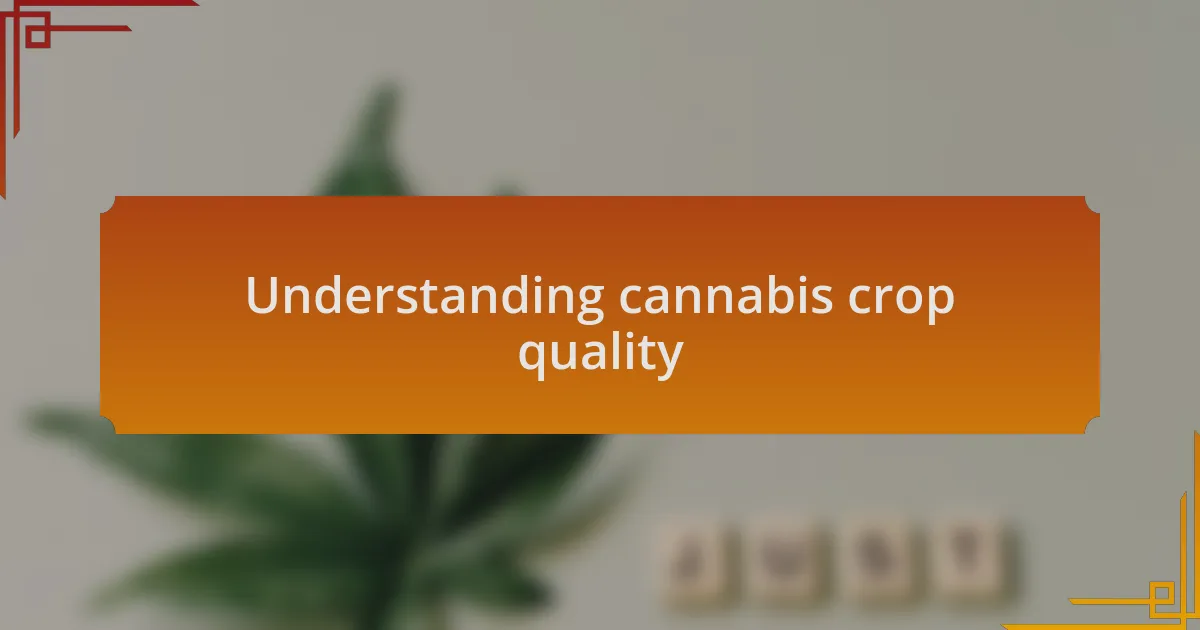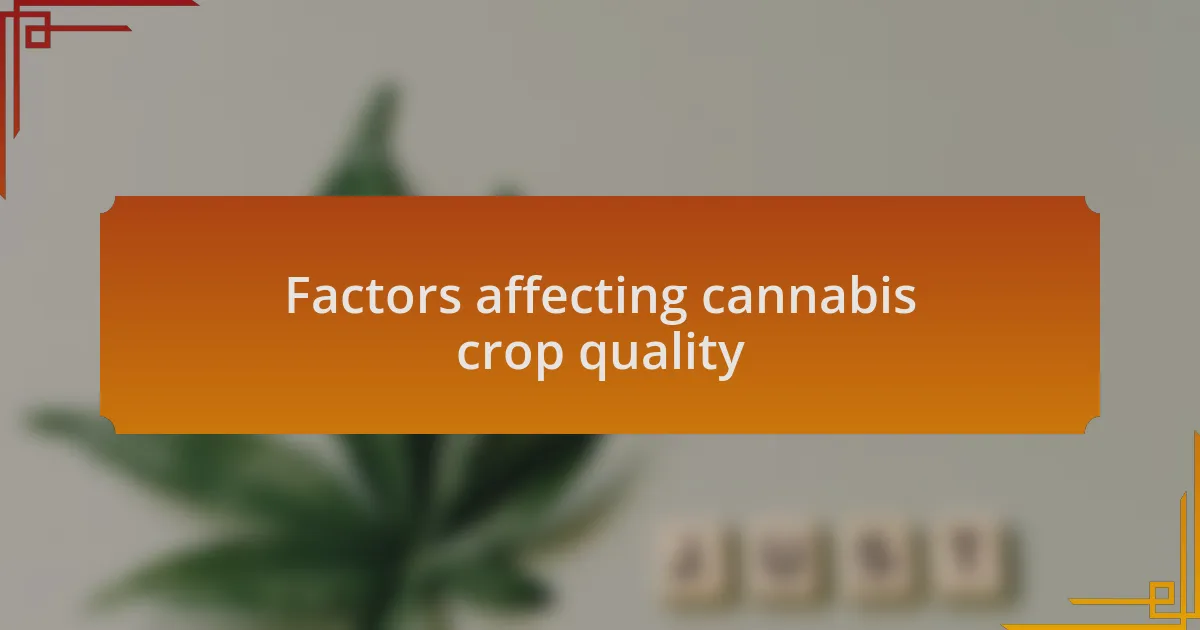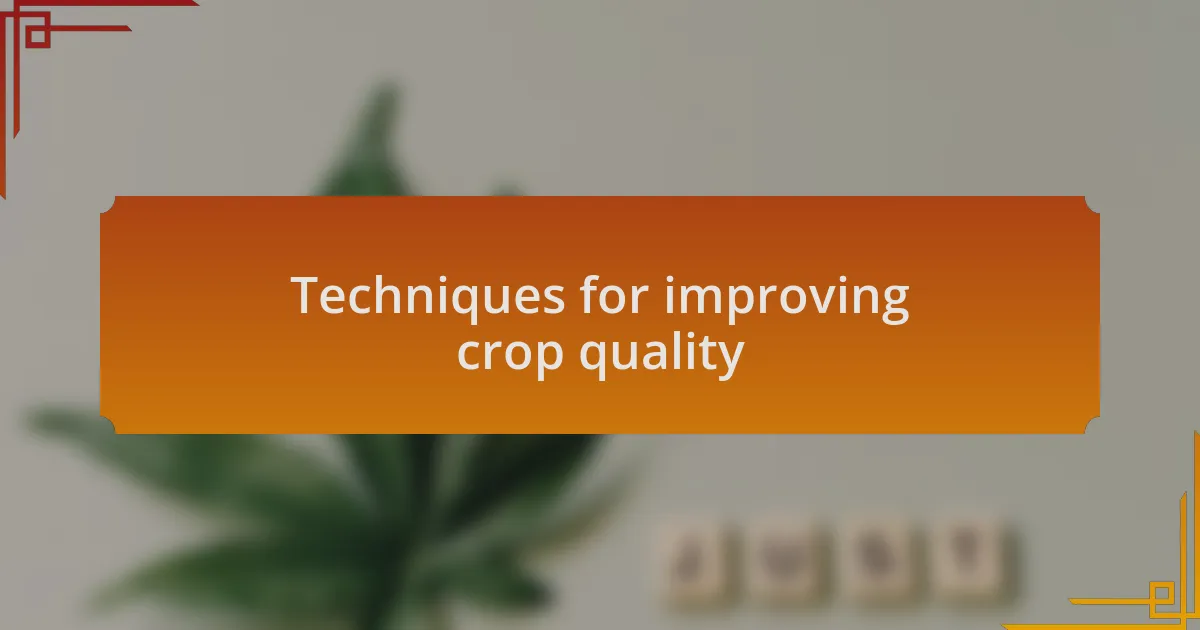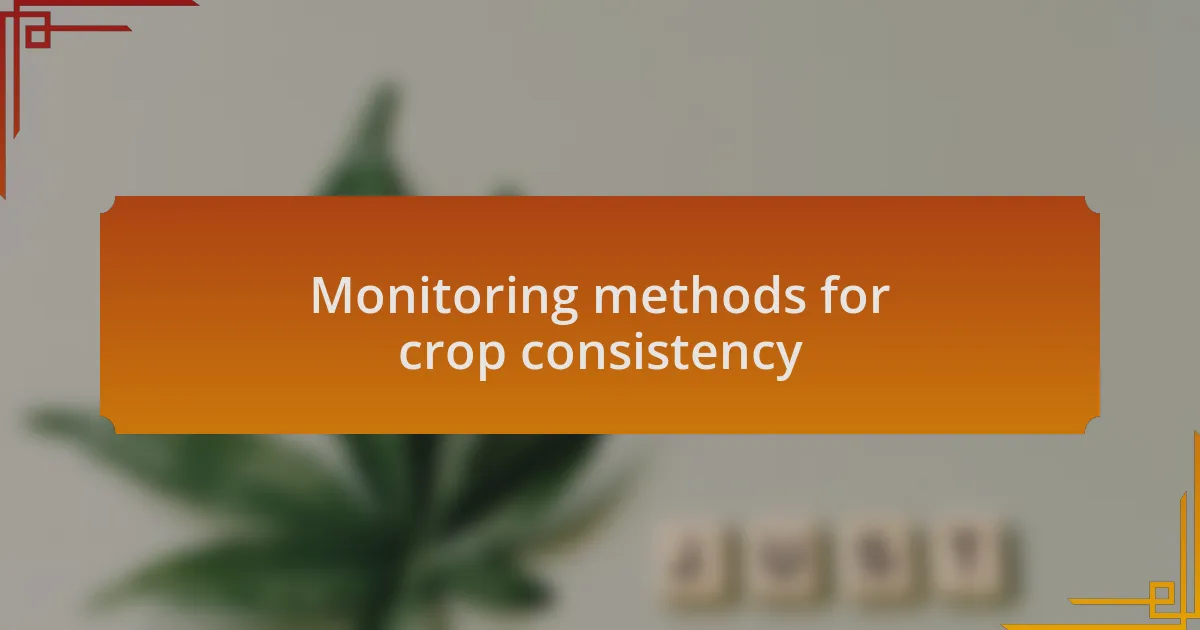Key takeaways:
- Aroma, trichome development, and growing conditions significantly impact cannabis crop quality beyond just appearance.
- Tailoring nutrient profiles to specific strains and ensuring water quality are crucial for optimal plant health and yield.
- Implementing advanced cultivation techniques like low-stress training and climate control can greatly enhance crop quality.
- Monitoring methods such as soil sensors and regular inspections help maintain consistency and identify issues early.

Understanding cannabis crop quality
Understanding cannabis crop quality goes beyond just looking at the size and color of the buds. Personally, I’ve found that the aroma and trichome development are just as critical indicators of quality. When I first started growing, I was amazed at how the scent of the plant changed at different growth stages; it really drove home the importance of these sensory elements.
Quality is often measured by potency, which is determined by cannabinoid concentration. I remember a particular harvest where I was certain I’d achieved my best yield, only to find out that the cannabinoid levels were lower than expected. This experience taught me that appearance can be deceiving and that understanding the full spectrum of factors influencing potency is crucial to consistency.
Another aspect I consider essential in assessing crop quality is the growing environment. Have you ever noticed how weather and soil conditions can dramatically affect growth? I learned this lesson the hard way during a rainy season, which led to mildew and reduced quality. It was a wake-up call that underscored the need for diligent monitoring of both environmental conditions and plant health.

Factors affecting cannabis crop quality
When it comes to cannabis crop quality, something I’ve become increasingly aware of is the impact of nutrients. Initially, I followed generic feeding schedules, thinking all plants had the same needs. However, after a couple of disappointing harvests, I realized that tailoring nutrient profiles to the specific strain made a huge difference. Have you ever seen your plants react positively to a nutrient adjustment? It’s truly rewarding to watch them thrive when they get exactly what they need.
Water quality is another critical factor that I’ve learned not to overlook. I once used tap water for irrigation without considering the chlorine and minerals it contained. The result was stunted growth and a significant dip in my crop’s overall quality. Since then, I’ve invested in a filtration system, and it’s incredible how much cleaner and healthier my plants look now. Have you thought about the water you’re using for your cannabis? It can be the difference between a mediocre harvest and something exceptional.
Lastly, I can’t stress enough the importance of genetics in determining crop quality. I made the mistake of choosing seeds based solely on price rather than lineage and reputation. It took me a while to grasp that high-quality genetics can significantly enhance yield and potency. Have you ever experienced the thrill of growing a recognized strain versus an unknown one? The results can be vastly different, helping us appreciate how foundational genetics is in the cannabis cultivation journey.

Techniques for improving crop quality
When it comes to improving crop quality, I’ve found that employing advanced cultivation techniques can yield remarkable results. For instance, I’ve experimented with techniques like low-stress training (LST), which allows me to manipulate the plant’s shape and maximize light exposure. The first time I tried LST, I marveled at the difference it made; my plants not only grew more vigorously, but they also produced larger buds. Have you ever adjusted the way you interact with your plants and noticed them responding in kind?
Light management is another technique I consider crucial. I invested time in understanding the ideal light spectrum for flowering and vegetative stages, switching between LED and HPS lights depending on the growth phase. Each time I adapt the lighting, I feel a thrill seeing the plants respond; the color and vigor seem to transform right before my eyes. It’s a reminder of the importance of creating the right environment. Have you thought about how your lighting setup affects your plants’ potential?
Climate control has been a game changer for me, too. Learning how to optimize temperature and humidity levels has had a direct impact on my crop quality. I once struggled with mold issues when humidity levels were too high, and it was disheartening to see those beautiful buds spoiled. After investing in a proper HVAC system and using hygrometers to monitor conditions, the improvement was immediate. Have you faced similar challenges in managing your grow room climate? Finding that balance has totally transformed my cultivation experience, and I can’t stress enough how essential it is.

Monitoring methods for crop consistency
To ensure consistent crop quality, I’ve integrated a variety of monitoring methods into my cultivation routine. One technique I’ve found particularly useful is the use of sensors to track and record environmental factors. I remember the relief I felt when I installed a soil moisture sensor; it took away the guesswork from irrigation. Have you ever felt anxious about whether your plants were thirsty or overwatered? Now, with real-time feedback, I can easily maintain optimal moisture levels, leading to healthier and more uniform crops.
Another method is implementing regular leaf and bud inspections. I’ve developed a keen eye for signs of nutrient deficiencies or pest issues that may compromise crop consistency. I still recall a time when I nearly overlooked a small aphid infestation; I caught it just in time after a detailed weekly inspection. Do you take the time to examine your plants closely? Fostering this routine has not only enhanced my crop quality but also strengthened my connection to the plants, as I become more attuned to their needs.
Finally, I can’t emphasize enough the importance of using laboratory testing for both soil and plant tissue. Whenever I receive data on nutrient levels, I feel like I’m holding a treasure map to improved yields. With lab results, I can tailor my fertilization strategy, ensuring my plants receive exactly what they need. Have you ever experienced the satisfaction of fine-tuning your approach based on solid data? This practice has continually helped me achieve the consistency I strive for in every harvest.

Lessons learned from past experiences
When reflecting on my past experiences, I realize that patience has been one of the most valuable lessons. There was a time when I rushed the drying process, eager to sample my harvest. The result? Uneven moisture content and a loss in flavor profile. Have you ever been tempted to skip a step when you’re excited about your work? Now, I take the time needed to properly dry and cure my buds, allowing their full potential to shine through—something that transforms the final product completely.
Another important takeaway has been the significance of strain selection. Early in my journey, I experimented with multiple strains simultaneously, hoping to find the ‘perfect’ one. Instead, I ended up with a chaotic array of variable qualities. It taught me the value of focus and understanding what each strain requires. Do you sometimes bite off more than you can chew? Since then, I have concentrated my efforts on a few specific varieties, leading to a more consistent and manageable crop outcome.
Lastly, I’ve learned to embrace failures as stepping stones toward success. There were instances when I faced a poor yield due to inadequate pest management. Instead of feeling defeated, I used these setbacks to enhance my knowledge. Have you ever turned a setback into a learning opportunity? By analyzing what went wrong, I improved my cultivation strategies, ultimately leading to more successful and high-quality harvests down the line. Each mistake has served as a reminder that growth, both in plants and in skills, is often born from challenges.